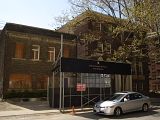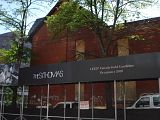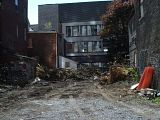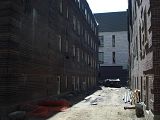From the Globe, by Ivor Tossell:
Goodbye, Victorian holdouts
Besieged by redevelopment on all sides, these crumbling historic homes can't escape the wrecking ball any longer
IVOR TOSSELL
Special to The Globe and Mail
May 3, 2008
Nineteen years ago, a group of University of Toronto students gathered in a field south of Bloor Street and started blowing up black helium balloons. At the suggestion of then city councillor Jack Layton, they tied the balloons to 45-metre tethers and used them to trace the imaginary outlines of a luxury hotel the university wanted to build on Charles Street West at the corner of St. Thomas, demolishing a row of historic homes in the process.
Then they called the press.
"The question was, how can we impress on people that this is going to be a massive development that's going to upset the environment," recalls Charles Blattberg, who was then president of U of T's student council and now is a professor of political philosophy at the University of Montreal.
The students succeeded in stalling that development until it was cancelled, and the houses were spared. But today, the three boarded-up buildings have lost the battle against time. Almost the last remnants of a stately, tree-lined university street west of Bay Street, they're about to be demolished to make way for a 23-storey luxury condominium, the St. Thomas, and an attached apartment block.
Proponents of the old houses say it's "demolition by neglect." The university says students are best served by the redevelopment. And everyone seems to be drawing their own lessons from the saga.
"It was like walking into a park," says Susan Stock, a conservator at the nearby Royal Ontario Museum who has worked in the area for decades and fought the latest development as a member of the city's Heritage Preservation Panel. "In 20 years, all of that has been lost."
Patterned after British colleges, Victoria University's stately buildings once shared the sidewalks with rows of turn-of-the-century semi-detached houses. Victoria - one of U of T's constituent universities, which have a degree of financial autonomy - began buying up houses in the area in the 1940s. By the end of the sixties, it owned most of the block.
Victoria redeveloped the south side of Bloor Street, parts of which it still owns, using proceeds from the now-iconic Colonnade building to fund its academic activities. The surviving houses were always slated for redevelopment, and the university used them for everything from storage to student housing.
In the late 1980s, however, plans to build a luxury hotel on the site led to that full-on protest that saw sit-ins, demonstrations and crowds packing City Hall, which rejected the proposal. "The feeling was, you want to retain some of the character," Mr. Layton recalls.
On appeal, the Ontario Municipal Board green-lit the hotel, but by the time the appeal was finished, the market had changed, and the hotel deal fell through. The houses were saved, but the university left them empty, waiting for a chance to redevelop them. Other proposals came and went in the 1990s, until the current project, with developer Minto, was hatched in 2004 and approved by the OMB in 2007.
Much had changed in the interim. The rest of the old houses lining Charles Street vanished, consumed by projects big and small, from the bright-white Robert Stern luxury tower, to student residences and the universally lauded Toronto office of McKinsey & Co., a building that will return to Victoria's ownership at the end of a 40-year lease.
(The rental portion of the Minto project will also return to university hands.)
Meanwhile, as the old houses decayed, generations of student leaders came and went, and memories of the protest faded. Today's student leaders are broadly supportive of the condo development, largely for the revenue it will generate.
"We can offer so many scholarships and so many bursaries to incoming students," says James Janeiro, the incoming president of Victoria's student body. "From that perspective, we are on-side."
Zinzi De Silva, the outgoing student president, says she understood condo developers to be offering "mid-seven-to-low-eight-figure deals" for the property. The university wouldn't confirm how much the Minto deal is worth.
The university says the case for preservation is weakened by the fact that they now stand alone, out of context - never mind that Victoria already has a stable of expensive architectural gems to maintain.
"We always saw those major institutional heritage buildings as the things that should excite our imagination and get first priority in terms of budget," says Larry Kurtz, Victoria's former bursar, who spearheaded efforts to develop the site.
None of which placates the critics, who question the wisdom of funding universities by developing campuses. Mr. Blattberg still shakes his head at the lack of student opposition today. "That's our Achilles heel; the institutional memory of the place is virtually erased every year."
Preservationists such as Ms. Stock, having lost the latest fight to save the houses, say the new developments are destroying the collegiate ambience that gave them cachet. That, she says, bodes poorly for the quality of student life. "You're going to have all those people in all those condos with their dogs pooping in the Victoria College quad."
AoD




